Best UI UX Tools – Expert Comparison 2025
Discover the best UI UX tools 2025 with our expert comparison of 5 top products for your design needs.

Finding the right partner for your product design or UX challenge can be the start of real transformation. Each approach brings something unique. Some teams dig deep into data and user research while others focus on fast results and proven talent. You might be looking for flexible experts to jump in right away or a partner to help shape your long term vision. Wondering which path brings results closest to your goals and your budget There is a lot to discover and the differences could make a real impact on how your product works and feels.
Table of Contents
The Good Side
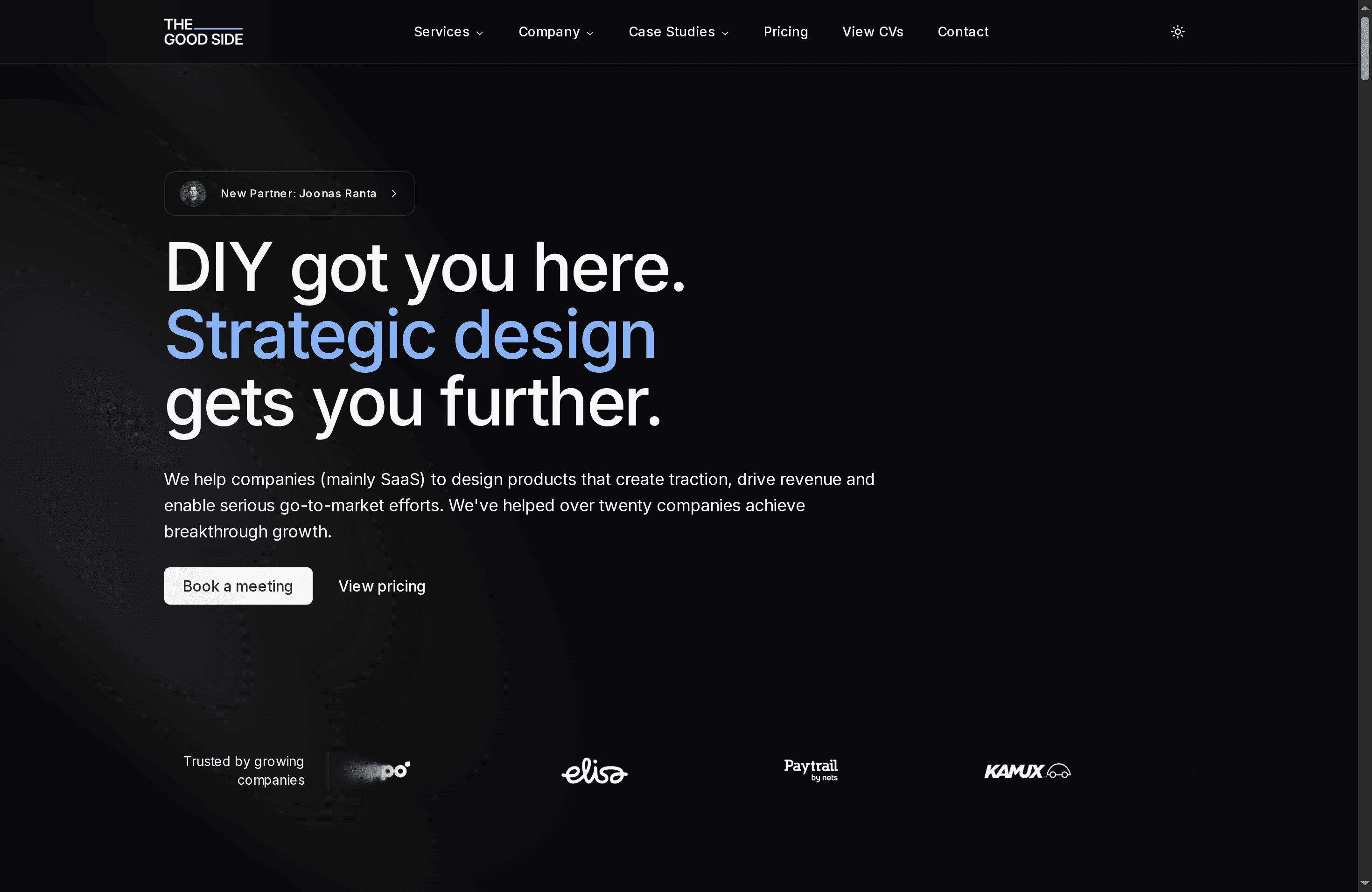
At a Glance
The Good Side is a strategic design partner focused squarely on SaaS companies, delivering senior-led UI/UX design, user flow optimization, and strategic positioning that drive activation, conversions, and revenue. Engagements are flexible—ranging from quick UI fixes to fully embedded design teams—with a streamlined onboarding that gets teams working together within two weeks. It’s an excellent match for product teams that need measurable outcomes and rapid impact, though the specialist, high-touch model may be a deliberate fit for growth-stage SaaS rather than bootstrapped micro-startups.
Core Features
The Good Side combines SaaS-specific product design, UI/UX, and user flow optimization with strategic positioning and growth-driven design work. Core capabilities include flexible engagement models (quick fixes, part-time, or full-time teams), a streamlined two-week onboarding process that begins with a free consultation and design audit, and access to a network of 100+ SaaS-focused designers. The offering spans UX research, product design, service and business design, and dedicated efforts to align product, website, and onboarding into a unified experience.
Pros
- Fast onboarding: The Good Side starts work within two weeks and pairs you with senior designers, enabling rapid momentum without long hiring cycles.
- Flexible engagements: You can choose quick UI fixes, part-time consulting, project-based work, or fully embedded teams to match your immediate needs and budget.
- Transparent pricing: Pricing is clear at €110/hour with defined scopes and adjustable durations for fixed-term partnerships, which simplifies procurement and forecasting.
- SaaS specialization: The team’s focus on SaaS means recommendations are tailored to product-led growth, onboarding funnels, and conversion levers specific to subscription products.
- Proven impact: Real-world testimonials and case studies demonstrate measurable outcomes such as increased retention and conversion after short engagements.
Who It’s For
The Good Side is built for SaaS product teams—founders, product managers, growth teams, and CTOs—who need specialized, strategic design support to accelerate go-to-market outcomes and improve product-market fit. If you are an established or scaling SaaS company that values quick, measurable design impact and prefers senior-level expertise over apprenticeship-style engagements, this is for you. If you run a very early-stage, cash-constrained startup, the high-touch pricing model may be a conscious trade-off to consider.
Unique Value Proposition
The Good Side’s unique value lies in combining senior, SaaS-specialized talent with flexible delivery and a fast onboarding engine. Unlike generalist design shops, it offers a curated network of 100+ SaaS-focused designers and a process that begins with a free audit, rapid talent matching, and chemistry checks so you get the precise expertise you need—quickly. That specificity translates into stronger alignment between product strategy, onboarding, and revenue outcomes: you’re not just polishing interfaces, you’re redesigning the user journey to lift activation and conversions. The transparent €110/hour pricing and clear scopes make ROI easier to calculate, while fixed-term partnership options allow you to scale design capacity without the delays and overhead of hiring full-time staff.
Real World Use Case
A SaaS startup engaged The Good Side for a three-month overhaul of its UI and user flows; the project combined UX research, interface redesign, and conversion-focused onboarding work. The result was measurable: smoother flows, improved retention, and higher trial-to-paid conversion—outcomes tied directly to the strategic design changes implemented during the engagement.
Pricing
Starting at €110/hour with options to adjust duration and workload for fixed-term partnerships (for example, 2 months, 3 months, etc.).
Website: https://goodside.fi
UX Cabin
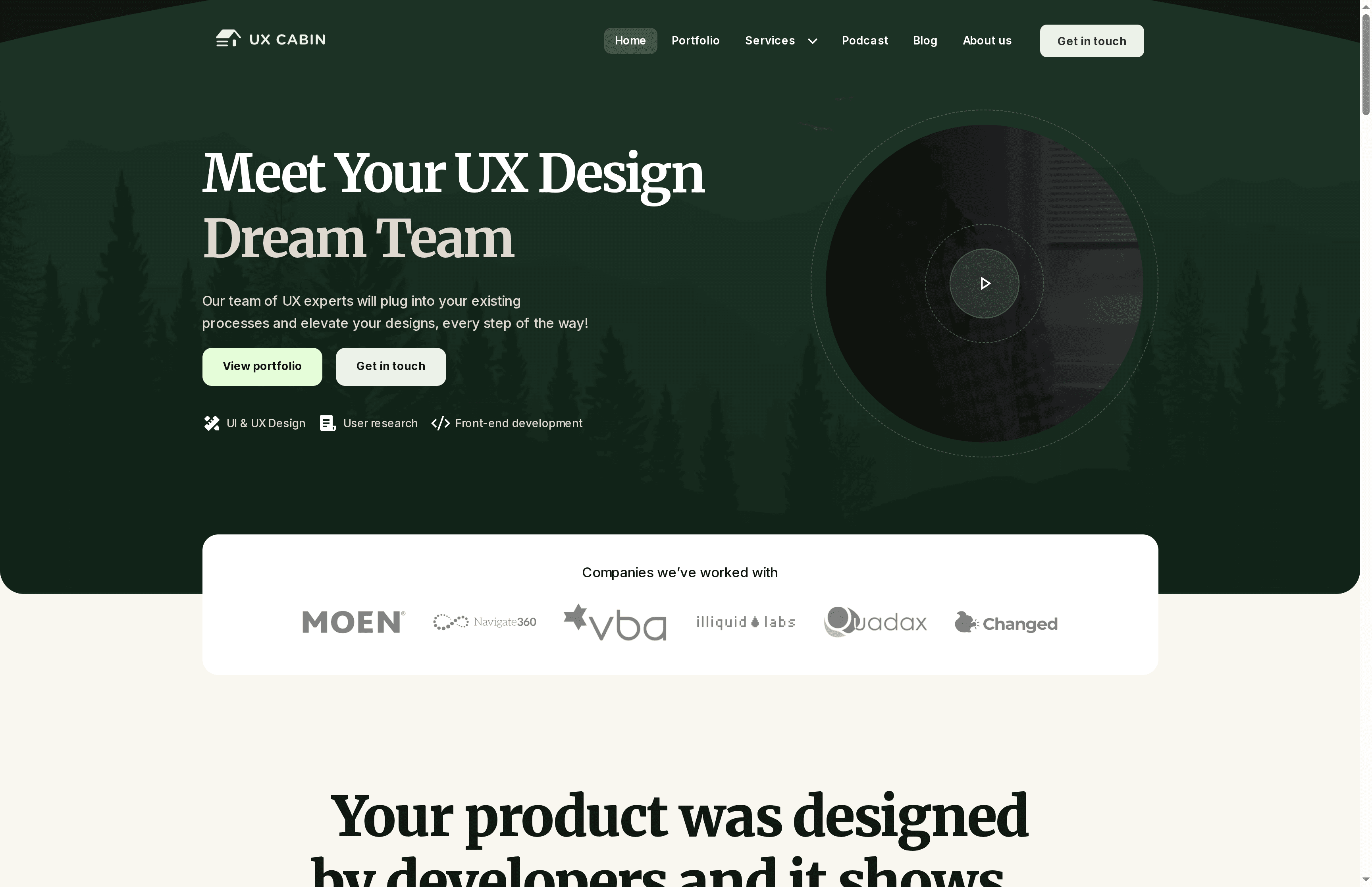
At a Glance
UX Cabin is a UX design agency that operates with the discipline and responsiveness of an in-house product team, focused on improving engagement and business outcomes for web and mobile apps. Their approach blends UX audits, design systems, and design sprints with user research to move ideas from discovery to delivery. For product teams that need experienced, flexible partners who prioritize measurable impact, UX Cabin is a practical, collaboration-first choice. Pricing transparency is limited, so you should expect a discovery call to uncover budget requirements.
Core Features
UX Cabin offers end-to-end UX services centered on solving usability and scalability problems: targeted UX audits to highlight friction and conversion leaks, design system creation to ensure coherent and scalable product UIs, and design sprints to accelerate validated prototyping. They pair these deliverables with user research to ground decisions in evidence and deliver UI/UX design for web, iOS, and Android platforms. The team’s stated emphasis on data and cross-industry experience means their deliverables are positioned to align design work with business goals rather than just aesthetics.
Pros
- Operates like an in-house team: UX Cabin presents itself as a flexible partner that integrates with product teams, which reduces handoff friction and speeds decision cycles.
- Comprehensive service offering: From audits and research to full UI execution and design systems, they cover the workflow many startups and scaleups need without stitching multiple vendors together.
- Proven portfolio with case studies: The agency highlights real projects that demonstrate their ability to deliver results, giving you concrete examples to evaluate fit.
- Business-focused UX outcomes: UX Cabin explicitly links UX improvements to business value and engagement, which helps justify design investments to stakeholders.
- Clear collaboration and communication: Their workflow emphasizes collaboration, which makes it easier for product managers and engineering leads to stay aligned throughout a project.
Cons
- No pricing published on the website, so initial vendor screening requires outreach and can slow procurement.
- Pricing model details are unavailable, meaning you may need multiple conversations to understand scope, timelines, and cost structure.
- Limited public information on team size and capacity, which makes it harder to assess whether they can scale quickly for larger or concurrent engagements.
Who It’s For
UX Cabin is best for startups, established SaaS companies, and product teams seeking a hands-on UX partner that can act like an embedded design team. If you need scalable design systems, rapid prototyping via design sprints, or evidence-driven UX audits to convince stakeholders, UX Cabin fits well. Expect a collaborative relationship rather than a fast, low-touch freelance engagement.
Unique Value Proposition
UX Cabin’s unique value is its blend of agency flexibility with in-house cadence: a data-oriented team that delivers both strategic research and production-ready UI assets while emphasizing business metrics. That combination reduces risk when you need dependable UX leadership without hiring full-time.
Real World Use Case
A concrete example: UX Cabin redesigned and built the LEOTR training platform, a web and mobile app for law enforcement training, demonstrating their ability to deliver tailored, user-centered solutions that span research, UI, and cross-platform implementation.
Pricing
Not specified on the website
Website: https://uxcabin.com
Toptal
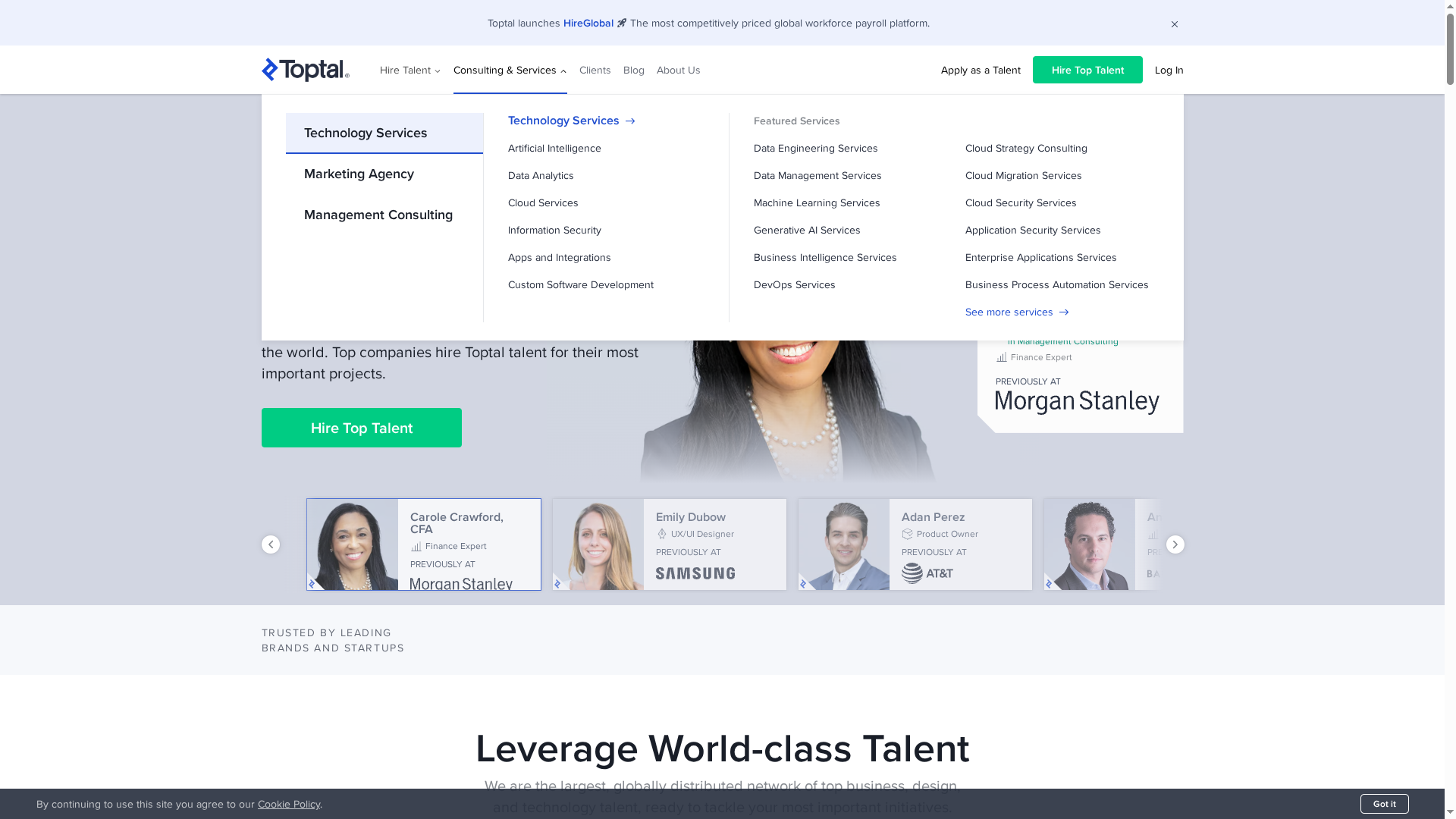
At a Glance
Toptal is an exclusive talent marketplace that connects companies with rigorously vetted experts across design, development, product, and marketing. Its core strengths are speed of assembly and a strict screening process that claims to filter for the top 3% of applicants, which makes it attractive for high-stakes projects. On the flip side, that level of quality comes with premium pricing and a narrower talent pool that may exclude promising emerging specialists. Bottom line: if reliability, speed, and proven senior-level expertise matter more than budget, Toptal is a strong candidate.
Core Features
Toptal offers a curated network model centered on rigorous screening, rapid team assembly, and flexible engagement types. The platform covers a wide range of roles — developers, designers, marketers, consultants, product managers, and project managers — and supports hourly, part-time, and full-time engagements. It emphasizes quick onboarding, sometimes delivering candidate matches within days or under 24 hours, and provides trial periods with satisfaction guarantees so you can validate fit before committing. These capabilities aim to reduce hiring friction and paperwork while prioritizing professionalism and quality.
Pros
- Access to top-tier global talent quickly and efficiently: Toptal’s vetting and matching processes are built to surface experienced professionals fast, helping teams move immediately on critical work.
- High quality of professionals due to strict screening process: Because applicants are filtered for top-percentile skills, you’re more likely to get senior-level contributors with proven experience.
- Flexibility in hiring models and scaling teams: You can engage talent hourly, part-time, or full-time, which supports different phases of product development and budget structures.
- Trial periods to ensure the right fit and satisfaction: The platform’s trial options let you validate working relationships before longer commitments.
- No hidden costs related to employment benefits or paperwork: Toptal simplifies contracting and reduces administrative overhead for companies that prefer vendor-managed relationships.
Cons
- Premium pricing that might be higher than other freelance platforms: The focus on top-tier professionals typically comes with rates above commodity freelance marketplaces.
- Limited to top-tier professionals, which might exclude emerging talent or niche skills: If you’re hunting for rising specialists, highly specific niches, or budget-friendly juniors, the pool may feel constrained.
- Some users report challenges in matching with the right talent quickly depending on role: While many matches are fast, certain specialized roles can take longer to fill than the advertised timelines.
Who It’s For
Toptal is best for businesses that need reliable, senior-level talent for critical projects where quality and speed matter more than cost. Ideal users include startups racing to market, product teams that require experienced designers and engineers, and enterprises needing contractors for strategic initiatives or digital transformation.
Unique Value Proposition
Toptal’s unique value is its combination of a highly selective vetting process with a fast, concierge-style matching service. That mix reduces hiring risk for high-impact work and gives product leaders a straightforward path to seasoned professionals without handling payroll complexities.
Real World Use Case
A technology startup facing a tight product deadline can use Toptal to assemble a remote team of experienced developers and designers within days, run a short paid trial to validate collaboration, and then scale the engagement to full-time work to accelerate launch.
Pricing
Quote-based; Toptal generally operates with fixed and hourly rates and is positioned at premium pricing tiers due to its top-tier talent.
Website: https://toptal.com
UX Studio
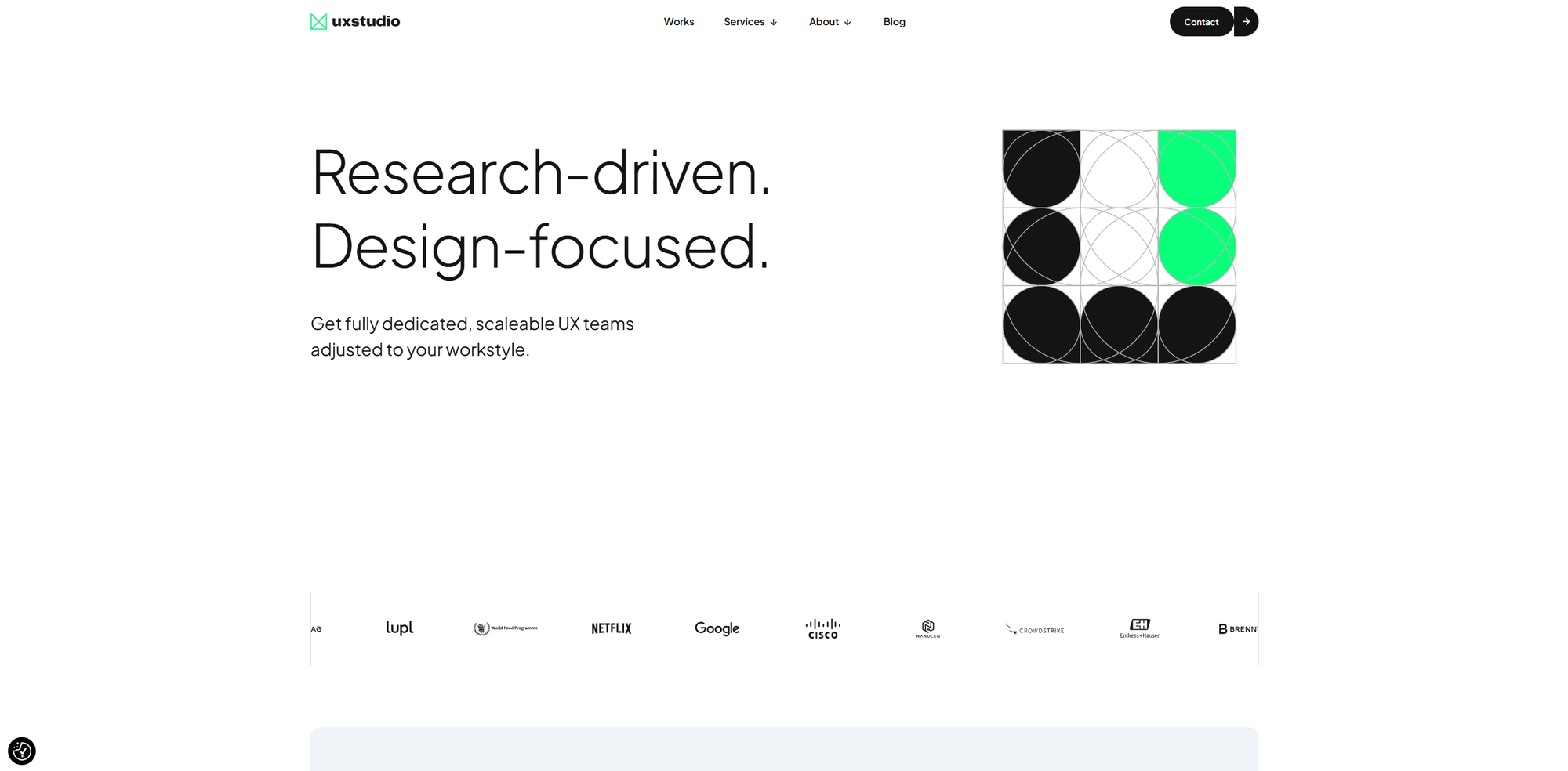
At a Glance
UX Studio is a research-driven, design-focused agency that embeds dedicated UX teams to help B2B SaaS companies simplify complex products. Their work centers on data-informed design, clear collaboration, and scalable design systems—so you get consistent output across products and releases. If your product suffers from tangled dashboards or clunky onboarding, UX Studio is built to tackle those exact problems. Expect a partnership model rather than a one-off vendor relationship.
Core Features
UX Studio provides dedicated and scalable UX teams that integrate with client workflows, offering services across UI/UX design, user research, and strategic consulting. They emphasize deep data analysis to guide design choices and specialize in visualizing complex data for impactful dashboards, streamlining onboarding flows, redesigning and polishing existing interfaces, and creating consistent, scalable design systems. They also offer full identity development for product launches and prioritize collaborative, transparent project execution.
Pros
- Dedicated team integration: UX Studio supplies teams that embed into your workflow, which reduces handoff friction and improves continuity across design sprints.
- Research-led approach: The strong emphasis on research ensures design decisions are evidence-based and aligned with real user needs.
- Measurable outcomes: The agency has a track record of delivering tangible results for clients, which helps justify investment in UX.
- Transparent communication: Clear, consistent project delivery practices make timelines and expectations easier to manage.
- Strength with complex SaaS: They demonstrate a particular ability to tackle complicated products and data visualization challenges, an advantage for analytics-heavy platforms.
Cons
- Limited pricing transparency: The website does not provide detailed pricing, which means you’ll likely need to invest time to scope and get a quote.
- Potential communication nuances: With a global team, there may be regional or language considerations that require deliberate coordination.
- Scope-by-inquiry model: Specific service pricing and exact scopes often need direct discussion, which can slow procurement for teams needing instant answers.
Who It’s For
UX Studio is ideal for B2B SaaS companies with complex products—particularly those that rely on data-heavy dashboards, multi-step onboarding, or require a refreshed UI/identity. You should consider them if you need a calm, research-first partner that can scale from part-time engagements to multi-quarter collaborations and wants to embed closely with your product team.
Unique Value Proposition
UX Studio’s unique value lies in combining research rigor with embedded team models: they don’t just deliver mockups, they provide scalable teams that marry data analysis with practical design systems, ensuring consistency and measurable improvements across product touchpoints.
Real World Use Case
A SaaS company outsources UX and UI improvements to UX Studio to streamline dashboards, improve onboarding, and enhance overall usability; the result is smoother user flows, higher adoption, and clearer product communication that supports growth initiatives.
Pricing
Not specified; likely custom based on scope and needs.
Website: https://uxstudioteam.com
IDEO
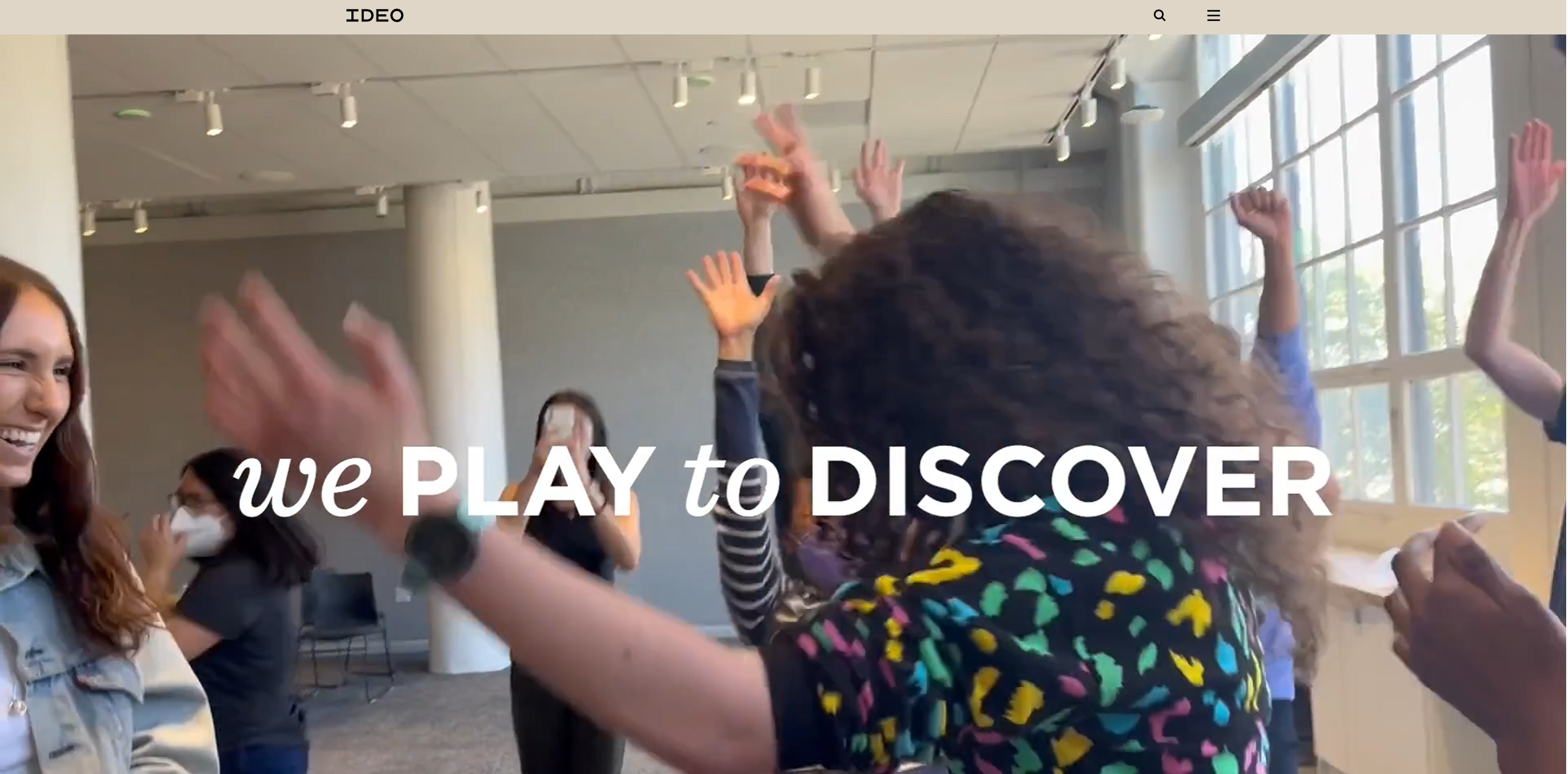
At a Glance
IDEO is a global design and innovation firm with more than 40 years of experience helping organizations invent products, services, and strategic futures. Its strength is deep, multidisciplinary design expertise applied across sectors, from health tech to automotive. If you need transformational outcomes rather than an off-the-shelf UI tool, IDEO is a heavyweight partner — but expect a consultative engagement rather than transparent packaged pricing.
Core Features
IDEO specializes in designing breakthrough products, brands, services, and experiences while also building strategic futures and creative capabilities inside client organizations. Their work combines hands-on product and service design with foresight-led strategy and capability building, enabling clients to prototype tangible visions and embed new ways of working. The portfolio emphasizes outcome-driven projects across products, services, and systems, with sustainable and impact-minded approaches.
Pros
- Decades of proven experience: IDEO’s 40-plus years in innovation mean they bring institutional knowledge and patterns that accelerate discovery and reduce early-stage risk.
- Broad, multidisciplinary services: They cover product, brand, service, and systems design, which helps organizations align experience and strategy end to end.
- Track record of growth outcomes: The firm highlights successful projects that have driven significant organizational growth, demonstrating practical, measurable impact.
- Cross-industry perspective: A robust portfolio across industries gives clients cross-pollinated ideas and novel solution patterns that single-industry shops may miss.
- Sustainability and long-term impact focus: IDEO shows an emphasis on sustainable, impactful solutions rather than temporary fixes, supporting lasting transformation.
Cons
- Website leans toward case storytelling rather than service granularity: The site emphasizes project descriptions and outcomes, which can make it hard to quickly understand specific service packages or deliverables.
- No explicit pricing published: There is no pricing information on the website, so budgeting requires a direct conversation and proposal.
- Scope and costs require direct consultation: Potential clients should expect a discovery phase or contact to define scope, timeline, and fees rather than selecting a self-serve plan.
Who It’s For
IDEO is best for organizations and leaders seeking strategic design expertise to tackle complex challenges, create new product or service categories, or shift organizational capability. If you’re a founder, product leader, or executive looking to reframe a problem, prototype future scenarios, and develop internal creative capacity, IDEO fits your needs. If you need a quick, low-cost UI kit, this is not the right match.
Unique Value Proposition
IDEO combines decades of design practice with strategic futures and capability building, offering clients both visionary direction and practical design execution. Their unique edge is turning fuzzy long-term ambitions into tangible prototypes and organizational skills that stick — not just recommendations.
Real World Use Case
A health tech startup partners with IDEO to design a patient-centered health management platform, leveraging IDEO’s product design and service mapping to improve adoption and clinical workflows. An automotive company engages IDEO to envision future mobility services and translate those futures into viable pilot offerings.
Pricing
Not specified on the website.
Website: https://ideo.com
Design and Strategic Partnership Tools Comparison
This table provides an overview of various design and strategic partnership tools for SaaS and other businesses, detailing their features, advantages, limitations, pricing, and target users.
| Company | Features & Pros | Cons | Pricing | Best For |
|---|---|---|---|---|
| The Good Side | SaaS-specific design, fast onboarding, flexible engagements, €110/hr Proven impact |
High-touch model may not suit bootstrapped startups | €110/hr | Established SaaS needing quick, measurable design impact |
| UX Cabin | UX audits, design systems, design sprints, user research, business-focused outcomes | No pricing info, limited team size details | Not specified | Startups needing scalable design systems and UX audits |
| Toptal | Rapid team assembly, top 3% vetted talent, flexible commitments, trial periods | Premium pricing, limited emerging talent, potential matchmaking delays | Quote-based | Businesses needing reliable, senior-level talent for critical projects |
| UX Studio | Dedicated UX teams, research-led design, complex SaaS specialization | Limited pricing transparency, potential for regional communication nuances | Not specified | B2B SaaS with complex products requiring research-first design |
| IDEO | Multidisciplinary, strategic foresight, capability building | No pricing info, requires consultative engagement | Not specified | Organizations seeking transformational outcomes and strategic design expertise |
Unlock Your SaaS Product’s Full Potential with Expert UI/UX Design
The challenge of choosing the best UI UX tools for 2025 reveals a deeper issue many SaaS companies face: unprofessional interfaces and disconnected user journeys that block activation and conversion growth. If your product struggles with unclear positioning or lacks strategic design focus, you are not alone. The Good Side Oy specializes in transforming these pain points into cohesive, high-performing experiences by providing senior, SaaS-focused design talent who bring measurable impact to your product.
Fast onboarding, flexible engagement, and transparent pricing mean your team can start improving interfaces and optimizing user flows quickly without the delays and costs of traditional hiring. With a proven process beginning with a free design audit and rapid talent matching, The Good Side aligns your product, website, and onboarding into a unified journey that drives revenue and user retention.
Elevate your SaaS UI UX strategy today by partnering with experts who understand exactly what it takes to convert users and grow sustainably.
Discover how expert strategic design can sharpen your competitive edge at The Good Side.
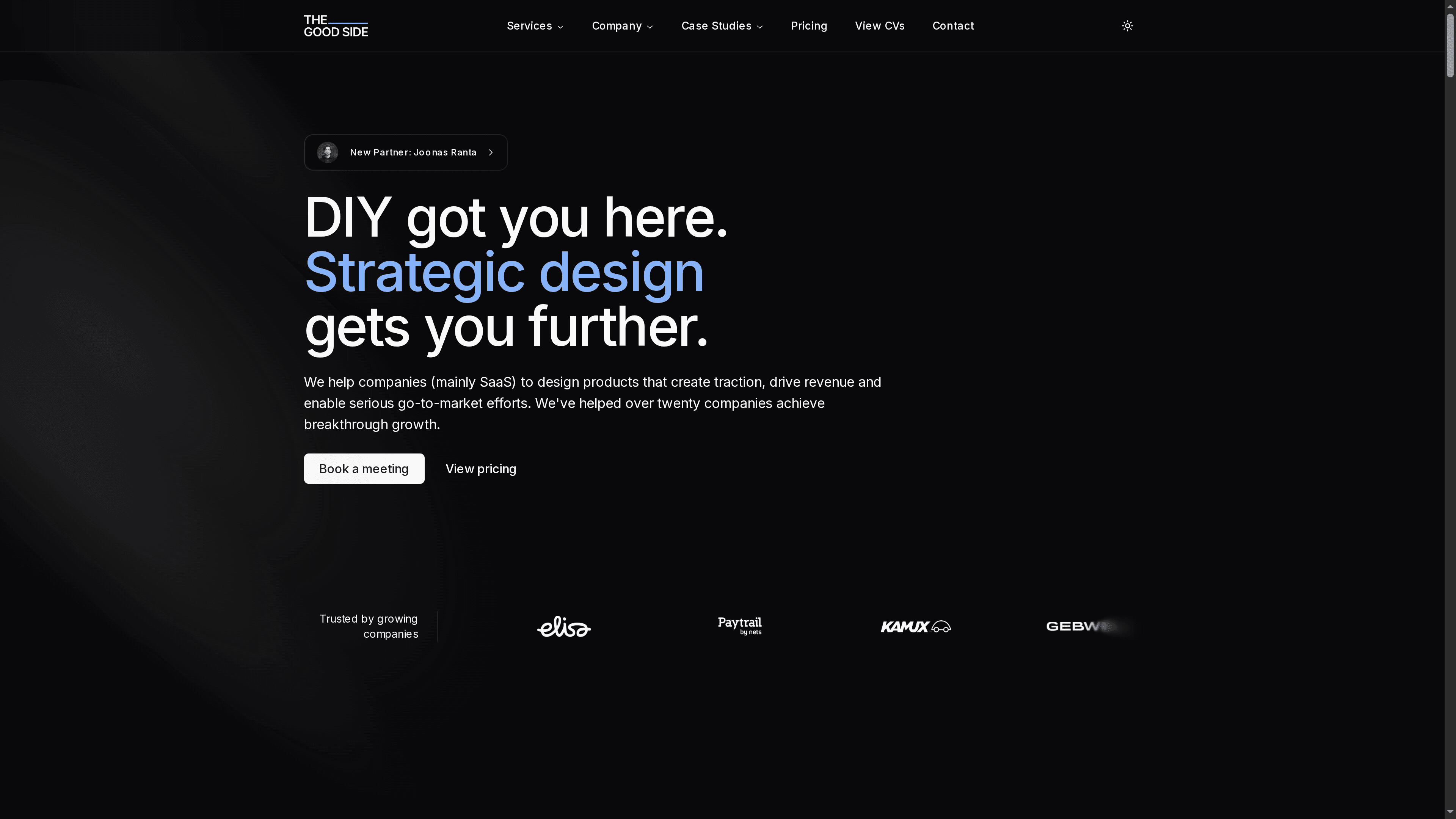
Ready to move beyond just picking the right tools? Let The Good Side’s flexible SaaS design services deliver the senior-level expertise your team needs now. Begin with a free design audit and see measurable results within weeks. Visit https://goodside.fi to get started.
Frequently Asked Questions
What are the key features to look for in UI UX tools in 2025?
Focus on tools that offer collaborative design capabilities, prototyping, and user testing functionalities. Prioritize features that streamline workflows and enhance team communication to improve project outcomes.
How can I determine which UI UX tool is best for my project?
Evaluate your specific needs, such as team size and project complexity, to select a tool that best aligns with your objectives. Create a checklist of essential features and assess tools against these criteria.
What steps should I take to implement a new UI UX tool?
Begin by identifying the tool’s installation or onboarding requirements, then involve your team in a demonstration or training session. Aim to deploy the tool fully within a month to maximize productivity.
How do UI UX tools improve user engagement metrics?
Effective UI UX tools provide insights into user behavior through analytics, helping you refine design elements accordingly. Track defined metrics like session duration and conversion rates to measure engagement improvements post-implementation.
Are there any specific metrics to track after using UI UX tools?
Yes, focus on metrics such as user satisfaction scores, task completion rates, and bounce rates. Monitor these metrics over a 60-day period post-implementation to gauge the impact and effectiveness of your design changes.